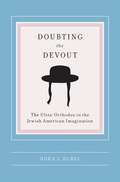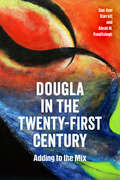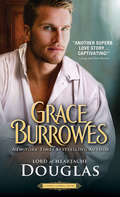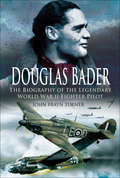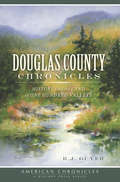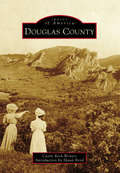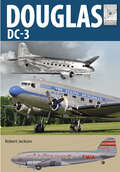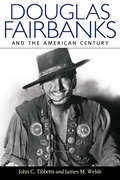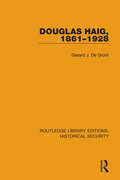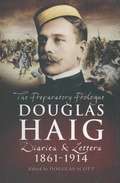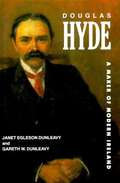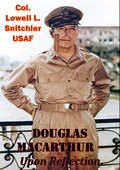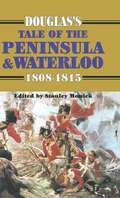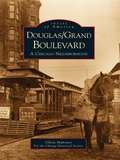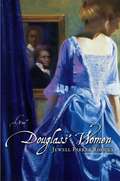- Table View
- List View
Doubting Thomas?: The Religious Life and Legacy of Thomas Jefferson
by Jerry Newcombe Mark A. BelilesA religious historian argues that historical revisionism has distorted the religious views of Thomas Jefferson, making him appear far more skeptical than he was. Thomas Jefferson and the founding fathers intended a strict separation of church and state, right? He would have been very upset to find out about a child praying in a public school or a government building used for religious purposes, correct? Actually, the history on this has been very distorted. The standard accepted story on the faith of Thomas Jefferson (or the lack thereof) is not accurate. While he did harbor some doubts about orthodox Christianity by the end of his life, he was actually quite active in supporting the church in America. Meanwhile, in his name today, because of a misunderstanding about &“the separation of church and state&” (a phrase that comes from an obscure letter he wrote), religious expression is being curtailed all over the place in modern America. And he would absolutely object to that, as seen in his own actions and writings. While Jefferson may seem to be the patron saint of the ACLU, his words and actions showed that he would totally disagree with the idea of driving God out of the public square. Doubting Thomas documents that. In short, it&’s time to set the record straight.
Doubting the Devout: The Ultra-Orthodox in the Jewish American Imagination (Religion and American Culture)
by Nora L RubelBefore 1985, depictions of ultra-Orthodox Jews in popular American culture were rare, and if they did appear, in films such as Fiddler on the Roof or within the novels of Chaim Potok, they evoked a nostalgic vision of Old World tradition. Yet the ordination of women into positions of religious leadership and other controversial issues have sparked an increasingly visible and voluble culture war between America's ultra-Orthodox and non-Orthodox Jews, one that has found a particularly creative voice in literature, media, and film.Unpacking the work of Allegra Goodman, Tova Mirvis, Pearl Abraham, Erich Segal, Anne Roiphe, and others, as well as television shows and films such as A Price Above Rubies, Nora L. Rubel investigates the choices non-haredi Jews have made as they represent the character and characters of ultra-Orthodox Jews. In these artistic and aesthetic acts, Rubel recasts the war over gender and family and the anxieties over acculturation, Americanization, and continuity. More than just a study of Jewishness and Jewish self-consciousness, Doubting the Devout will speak to any reader who has struggled to balance religion, family, and culture.
Doubting the Divine in Early Modern Europe: The Revival of Momus, the Agnostic God
by George McClureIn this book, George McClure examines the intellectual tradition of challenges to religious and literary authority in the early modern era. He explores the hidden history of unbelief through the lens of Momus, the Greek god of criticism and mockery. Surveying his revival in Italy, France, Spain, Germany, the Netherlands, and England, McClure shows how Momus became a code for religious doubt in an age when such writings remained dangerous for authors. Momus ('Blame') emerged as a persistent and subversive critic of divine governance and, at times, divinity itself. As an emblem or as an epithet for agnosticism or atheism, he was invoked by writers such as Leon Battista Alberti, Anton Francesco Doni, Giordano Bruno, Luther, and possibly, in veiled form, by Milton in his depiction of Lucifer. The critic of gods also acted, in sometimes related fashion, as a critic of texts, leading the army of Moderns in Swift's Battle of the Books, and offering a heretical archetype for the literary critic.
Dougla in the Twenty-First Century: Adding to the Mix (Caribbean Studies Series)
by Sue Ann Barratt Aleah N. RanjitsinghIdentity is often fraught for multiracial Douglas, people of both South Asian and African descent in the Caribbean. In this groundbreaking volume, Sue Ann Barratt and Aleah N. Ranjitsingh explore the particular meanings of a Dougla identity and examine Dougla maneuverability both at home and in the diaspora. The authors scrutinize the perception of Douglaness over time, contemporary Dougla negotiations of social demands, their expansion of ethnicity as an intersectional identity, and the experiences of Douglas within the diaspora outside the Caribbean. Through an examination of how Douglas experience their claim to multiracialism and how ethnic identity may be enforced or interrupted, the authors firmly situate this analysis in ongoing debates about multiracial identity. Based on interviews with over one hundred Douglas, Barratt and Ranjitsingh explore the multiple subjectivities Douglas express, confirm, challenge, negotiate, and add to prevailing understandings. Contemplating this, Dougla in the Twenty-First Century adds to the global discourse of multiethnic identity and how it impacts living both in the Caribbean, where it is easily recognizable, and in the diaspora, where the Dougla remains a largely unacknowledged designation. This book deliberately expands the conversation beyond the limits of biraciality and the Black/white binary and contributes nuance to current interpretations of the lives of multiracial people by introducing Douglas as they carve out their lives in the Caribbean.
Douglas
by Grace BurrowesDouglas Allen needs a home for his aching heart Douglas Allen, Viscount Amery, hates having arrived to his title without knowing how to manage his properties. Guinevere Hollister is a distant family connection raising her daughter in rural obscurity while stewarding the estate. Douglas reluctantly puts himself in Gwen's hands for lessons in land husbandry and discovers beneath her prickly exterior a woman of passion and honor. Yet despite the closeness they find, she will not marry him. Guinevere Hollister needs a champion When the powerful Duke of Moreland arranges an engagement between Gwen and his heir, Douglas knows the marriage is not what Gwen wants. In Douglas's eyes, Gwen deserves to make her own choices, and he will take on family, the meddling duke, and Gwen's own lonely, stubborn heart to ensure his lady's happiness. Another unforgettable Regency romance from award-winning, New York Times and USA Today bestselling author Grace Burrowes.
Douglas A-4 Skyhawk: Attack & Close-Support Fighter Bomber
by Jim WinchesterA detailed look at the combat aircraft designed by the legendary Edward H. Heinemann with one role in mind: tactical nuclear delivery. The Skyhawk first entered service with the US Navy almost 50 years ago. It is still in service with various US units and remains the backbone of many of the air forces of those countries to which it has been exported. &“Heinemann&’s Hot Rod&” was never called upon for its original purpose—nuclear delivery from aircraft carriers—but its well-designed airframe proved adaptable to many other uses. This is an in-depth look at the design, production, evolution, operation and performance of the aircraft. It will also include first-hand accounts of flying the Skyhawk in action.
Douglas Bader: The Biography of the Legendary World War II Fighter Pilot (Airlife Classics Ser.)
by John Frayn TurnerDouglas Bader was a legend in his lifetime and remains one today 100 years after his birth. A charismatic leader and fearless pilot he refused to let his severe disability (loss of both legs in a flying accident) ground him. He fought the authorities as ruthless as he did the enemy and not only managed to return to the front line but became a top scoring ace. His innovative tactics (The Big Wing) ensured his promotion and he led a key group of squadrons during the dark days of the Battle of Britain.His luck ran out when he was shot down and captured; he only escaped his burning fighter by cutting away one of his artificial legs. As a POW he was a thorn in the Germans side and he was sent to Colditz Castle. As this perceptive book reveals Bader, the hero, was at times a difficult overbearing man, no doubt in part due to the pain he suffered. But his strengths far outweighed his weaknesses and his place in the annuals of British history is secure.This is a timely republication of an important biography.
Douglas Copland
by Marjorie Harper'In Australia the name Copland is one to be conjured with.' The Canadian ambassador to China was addressing the diplomatic corps gathered to farewell Professor Douglas Copland, Australia's second Minister to China. It was early 1948, and Copland was leaving China to become founding Vice-Chancellor of the new Australian National University in Canberra. The compliment was a reference to Copland's outstanding career in Australia as an academic, applied economist, administrator and public intellectual. His academic writings were numerous and timely, his newspaper articles were widely syndicated and he was constantly in demand as a public speaker and broadcaster. Copland's name is perpetuated by a lecture theatre at the University of Melbourne, a building at ANU, a secondary college in the Canberra suburb of Melba and by a series of lectures sponsored by the Committee for Economic Development of Australia.
Douglas County Chronicles: History from the Land of One Hundred Valleys (American Chronicles)
by R. J. GuyerDouglas County, Oregon, stretches west from Crater Lake and the forested peaks of the Cascades until it reaches the shores of the Pacific in a tumult of rolling sand dunes. In this account, author R.J. Guyer recalls the frontier spirit and creative industry that shaped this land of one hundred valleys. Enjoy stories of Lookingglass's two-horse parking meter and Boswell Springs' cure-all mineral waters. Celebrate Reedsport's Olympic gold medalist and Oakland's one-time claim as turkey capital of the world. Remember the devastation of the Roseburg blast and the triumph of the Drain Black Sox's win in the National Baseball Conference World Series. From the establishment of the county to the preservation of historic landmarks, Guyer shares the rich heritage of Douglas County's communities.
Douglas County: A Photographic Journey (Images of America)
by Castle Rock Writers Shaun BoydCastle Rock Writers bring readers a collection of vintage images and sketches of Douglas County from approximately 1861 to 1950, covering the settling of towns such as Parker and Sedalia and rural areas like Cherry Valley and Daniel�s Park. Early homesteaders, adventurers, and prospectors journeyed west following the 900-plus miles along the Cherokee Trail, seeking the wealth of gold or needing the curative air of Colorado. On the long and arduous trip, travelers stopped at the Twenty Mile House in Parker or the Pretty Woman Ranch on the First Territorial Road. They needed to clean off the dust and dirt and enjoy a nourishing meal before the final push to Denver and beyond. Some simply stayed. They homesteaded ranches, staked out mines, and built small towns in the rolling plains, mesas, forested hills, and mountains that make up the 843 square miles of Douglas County. In the first half of the 20th century, the region grew into cohesive communities, where families thrived through ingenuity and hard work. Neighbors supported neighbors.
Douglas DC-3: The Airliner that Revolutionised Air Transport (FlightCraft #21)
by Robert JacksonA guide to the plane that changed commercial aviation: “A whopping 109 color photos shows kits in various stages of completion . . . Enjoyed it.” —Historical Miniatures Gaming SocietyNo airliner in the history of commercial aviation has had a more profound effect than the Douglas DC-3. Reliable and easy to maintain, it carried passengers in greater comfort than ever before.Its origins stem from a design by the Douglas Aircraft Company of Santa Monica, California. Known as the Douglas Commercial One, or DC-1, this new aircraft was revolutionary in concept. It was quickly developed into the DC-2, which led to Douglas’ domination of the domestic air routes of the United States, and of half the world.Experience with the DC-2 led to an improved version, the Douglas Sleeper Transport (DST), first flown on December 17, 1935. This in turn evolved into a 21-seat variant, the DC-3, featuring many improvements. The first American Airlines DC-3 entered service in June 1936, and within three years of its introduction the aircraft accounted for a staggering 95 percent of all US commercial air traffic. From commencement of service to the attack on Pearl Harbor, the DC-3 increased domestic revenue passenger miles more than fivefold. Of the 322 aircraft operated by the country’s airlines in December 1941, 260 were DC-3s. At the pre-war peak, 30 foreign airlines operated the DC-3. On the eve of war, the DC-3’s scheduled flights represented 90 percent of international air traffic.In addition to over 600 civil examples of the DC-3, 10,048 military C-47 variants were built, as well as 4,937 produced under license in the USSR as the Lisunov Li-2 and 487 built by Showa and Nakajima in Japan as the L2D. After the war, thousands of surplus C-47s were converted for civilian use. These aircraft became the standard equipment of almost all the world’s airlines, remaining in frontline service for many years. The ready availability of cheap, easily maintained ex-military C-47s, large and fast by the standards of the day, jump-started the worldwide postwar air transport industry.The full remarkable story of the DC-3, and its ancestor the DC-2, is told in these pages, providing a wealth of information for the modeler and the enthusiast alike.
Douglas Duncan: A Memorial Portrait
by Alan JarvisThis is an unusual memorial to an unusual man. Douglas Duncan was a Torontonian who, by his patronage of the arts, has had an almost incalculable influence on their development in Canada. A bibliophile all his life, he began by espousing bookbinding as his chosen profession and after studying in Paris he returned to Toronto to set up as a bookbinder in 1928. But this was only one part of his life, and while in Paris his interest in music and painting had grown and matured. In 1936 the Picture Loan Society was founded and Duncan, at first one of the Committee, soon became solely responsible for it. It is in this capacity that his influence was greatest: literally hundreds of Canadian artists owe to him, in some measure, a debt of gratitude for sound advice, encouragement, and help generously given. Ten informal essays have been contributed by people who knew Duncan well at different times and at various stages in his career. Because each contributor concentrates on the Douglas Duncan he knew the result is a personal, vivid and immediate portrait of a very attractive man. The book also includes reproductions of paintings by some of the artists whose work Duncan encouraged and collected, and examples of his work as a bookbinder and a photographer.
Douglas Fairbanks and the American Century
by John C. Tibbetts James M. WelshDouglas Fairbanks and the American Century brings to life the most popular movie star of his day, the personification of the Golden Age of Hollywood. At his peak, in the teens and twenties, the swashbuckling adventurer embodied the new American Century of speed, opportunity, and aggressive optimism. The essays and interviews in this volume bring fresh perspectives to his life and work, including analyses of films never before examined. Also published here for the first time in English is a first-hand production account of the making of Fairbanks's last silent film, The Iron Mask,/i>. Fairbanks (1883-1939) was the most vivid and strenuous exponent of the American Century, whose dominant mode after 1900 was the mass marketing of a burgeoning democratic optimism, at home and abroad. During those first decades of the twentieth century, his satiric comedy adventures shadow-boxed with the illusions of class and custom. His characters managed to combine the American Easterner's experience and pretension and the Westerner's promise and expansion. As the masculine personification of the Old World aristocrat and the New World self-made man--tied to tradition yet emancipated from history--he constructed a uniquely American aristocrat striding into a new age and sensibility. This is the most complete account yet written of the film career of Douglas Fairbanks, one of the first great stars of the silent American cinema and one of the original United Artists (comprising Fairbanks, Mary Pickford, Charles Chaplin, and D. W. Griffith). John C. Tibbetts and James M. Welsh's text is especially rich in its coverage of the early years of the star's career from 1915 to 1920 and covers in detail several films previously considered lost.
Douglas Haig And The Battle Of The Somme
by Major Harold M. Jensen Jr.This paper reviews the background, strategy, and tactics of Field-Marshal Sir Douglas Haig, Commander of the British Expeditionary Force in World War I. The planning and action at the Battle of the Somme is highlighted and analyzed.
Douglas Haig, 1861–1928 (Routledge Libary Editions: Historical Security)
by Gerard J. De GrootFor seventy years Douglas Haig had been portrayed on the one hand as the ‘Butcher of the Somme’ – inept, insensitive and archaic; and on the other as the ‘Saviour of Britain’ – noble, unselfish and heroic. This polarised, strident and ultimately inconclusive argument had resulted in Haig becoming detached from his own persona; he had become a shallow symbol of a past age to be pilloried or praised. The middle ground in the Haig debate had been as barren as No Man’s Land. There should be no mystery about Haig. Certain from a very early age of his own greatness, he preserved every record of his achievements: diaries, letters, official reports etc. The opinions of his contemporaries are likewise readily available. But until this book the material had not been used to construct a complete and accurate picture. Critics and supporters have raided the historical records for evidence of the demi-god or demon and have ignored that which conflicts with their preconceptions. They have likewise raced through his early life in order to get to the war, in the process ignoring the complex process of his development as a soldier. Analyses of Haig’s command have consequently been as shallow as the prevailing images of the man. After eight years of painstaking and detailed research into previously neglected sources, Gerard De Groot gave us a more complete and balanced picture. This book, originally published in 1988, which will appeal both to the general and the specialised reader, is not simply a critique of Haig’s command in the war, but an exploration into his personality. Close attention to his early life and career reveals him as a creature of his society, a man who mirrored both the virtues and the faults of Edwardian Britain. What emerges is an intense, dedicated, but ultimately flawed servant of his country whose ironic fate it was to grow up in one age and to command in another.
Douglas Haig: Diaries & Letters, 1861–1914
by Douglas ScottAs a young officer in the prestigious 21st Lancers (motto 'Death or Glory') Douglas Haig played a leading role in Kitchener's bold expedition which ended in the defeat of the Khalifa of Sudan at Omdurman. He described the action, as he did the whole campaign, vividly in words and diagrams which survived virtually untouched at the family home Bemersyde in the Borders. These letters and diaries allow the reader to trace Haig's career and developing character. What they reveal may well surprise his critics. Field Marshal Lord Haig will remain a hugely controversial figure due to his pre-eminent role during The Great War. He was a hugely popular public figure in the post WW1 years and revered by those who served under him. His death in 1928 was a major occasion for mourning. Only later was he heavily criticised for the slaughter of the trenches.
Douglas Haig: Diaries and Letters 1914-1918
by Dr Gary Sheffield MA FRHistS Dr John BourneThere's a commonly held view that Douglas Haig was a bone-headed, callous butcher, who through his incompetence as commander of the British Army in WWI, killed a generation of young men on the Somme and at Passchendaele. On the other hand, there are those who view Haig as a man who successfully struggled with appalling difficulties to produce an army which took the lead in defeating Germany in 1918.Haig's diaries, hitherto only previously available in bowdlerised form, give the C-in-C's view of Asquith and his successor Lloyd George, of whom he was highly critical. The diaries show him intriguing with the King vs. Lloyd George. Additional are his day-by-day accounts of the key battles of the war, not least the Somme campaign of 1916.
Douglas Haig: Diaries and Letters 1914-1918
by Gary Sheffield John BourneThere's a commonly held view that Douglas Haig was a bone-headed, callous butcher, who through his incompetence as commander of the British Army in WWI, killed a generation of young men on the Somme and at Passchendaele. On the other hand, there are those who view Haig as a man who successfully struggled with appalling difficulties to produce an army which took the lead in defeating Germany in 1918.Haig's diaries, hitherto only previously available in bowdlerised form, give the C-in-C's view of Asquith and his successor Lloyd George, of whom he was highly critical. The diaries show him intriguing with the King vs. Lloyd George. Additional are his day-by-day accounts of the key battles of the war, not least the Somme campaign of 1916.
Douglas Hyde: A Maker of Modern Ireland
by Janet Egleson Dunleavy Gareth W. DunleavyDouglas Hyde (1860-1949) was elected first president of modern Ireland in 1938. A Maker of Modern Ireland dispels the myths and misinformation that have obscured the private life of this extraordinary scholar and statesman.
Douglas MacArthur - Upon Reflection
by Col. Lowell L. Snitchler USAFGeneral-of-the-Army Douglas MacArthur was a complex man whose behaviors seem contradictory on the surface. In fact, he demonstrated an enduring pattern of perceiving, relating to, and thinking about himself and his environment. This consistent personality is evident across a wide range of social and personal contexts and can be traced back to his developmental childhood and adolescent years.This research recounts MacArthur's personality development from childhood, investigates his last military campaign, and, finally, applies the diagnosis of narcissistic personality disorder to the assembled data. Upon reflection, MacArthur's apparent behavioral inconsistencies are reconciled within this clinical framework.Finally, organizational, heuristic and predictive implications are drawn from this research. Academic and operational military uses are suggested.
Douglas MacArthur: American Warrior
by Arthur HermanA new, definitive life of an American icon, the visionary general who led American forces through three wars and foresaw his nation’s great geopolitical shift toward the Pacific Rim—from the Pulitzer Prize finalist and bestselling author of Gandhi & Churchill Douglas MacArthur was arguably the last American public figure to be worshiped unreservedly as a national hero, the last military figure to conjure up the romantic stirrings once evoked by George Armstrong Custer and Robert E. Lee. But he was also one of America’s most divisive figures, a man whose entire career was steeped in controversy. Was he an avatar or an anachronism, a brilliant strategist or a vainglorious mountebank? Drawing on a wealth of new sources, Arthur Herman delivers a powerhouse biography that peels back the layers of myth—both good and bad—and exposes the marrow of the man beneath. MacArthur’s life spans the emergence of the United States Army as a global fighting force. Its history is to a great degree his story. The son of a Civil War hero, he led American troops in three monumental conflicts—World War I, World War II, and the Korean War. Born four years after Little Bighorn, he died just as American forces began deploying in Vietnam. Herman’s magisterial book spans the full arc of MacArthur’s journey, from his elevation to major general at thirty-eight through his tenure as superintendent of West Point, field marshal of the Philippines, supreme ruler of postwar Japan, and beyond. More than any previous biographer, Herman shows how MacArthur’s strategic vision helped shape several decades of U.S. foreign policy. Alone among his peers, he foresaw the shift away from Europe, becoming the prophet of America’s destiny in the Pacific Rim. Here, too, is a vivid portrait of a man whose grandiose vision of his own destiny won him enemies as well as acolytes. MacArthur was one of the first military heroes to cultivate his own public persona—the swashbuckling commander outfitted with Ray-Ban sunglasses, riding crop, and corncob pipe. Repeatedly spared from being killed in battle—his soldiers nicknamed him “Bullet Proof”—he had a strong sense of divine mission. “Mac” was a man possessed, in the words of one of his contemporaries, of a “supreme and almost mystical faith that he could not fail.” Yet when he did, it was on an epic scale. His willingness to defy both civilian and military authority was, Herman shows, a lifelong trait—and it would become his undoing. Tellingly, MacArthur once observed, “Sometimes it is the order one disobeys that makes one famous.” To capture the life of such an outsize figure in one volume is no small achievement. With Douglas MacArthur, Arthur Herman has set a new standard for untangling the legacy of this American legend.
Douglas's Tale of the Peninsula & Waterloo, 1808–1815
by Stanley MonickThese are the memoirs of Sergeant John Dougl as, 3rd Battalion, The Royal Scots, and his experiences as a soldier from 1809-1817. The book provides a narrative of the Peninsular Campaign, with a descriptions of Quatre Bras an d Waterloo '
Douglas/Grand Boulevard: A Chicago Neighborhood
by Olivia Mahoney Chicago Historical SocietyThe history of Chicago can be told through its neighborhoods, and perhaps none is more telling than Douglas/Grand Boulevard on the city's south side. The future site of the neighborhood remained a sparsely settled prairie until the early 1850s, when Stephen A. Douglas purchased a large tract of land and began developing a residential subdivision for the wealthy. Douglas/Grand Boulevard: A Chicago Neighborhood explores the development of this distinctive community and the many obstacles its residents encountered. Originally a predominately white neighborhood, Douglas/Grand Boulevard became an African-American community during the Great Migration when thousands of Southern blacks moved north seeking greater opportunities. After the 1919 Race Riot, an increasing number of white residents moved away from the neighborhood, and the community became a national model of black achievement.
Douglass' Women
by Jewell Parker RhodesWINNER OF THE 2003 PEN OAKLAND JOSEPHINE MILES AWARD FOR OUTSTANDING WRITING AND THE BLACK CAUCUS OF THE ALA LITERARY AWARD Frederick Douglass, the great African-American abolitionist, was a man who cherished freedom in life and in love. In this ambitious work of historical fiction, Douglass' passions come vividly to life in the form of two women: Anna Murray Douglass and Ottilie Assing. Douglass' Women is an imaginative rendering of these two women -- one black, the other white -- in Douglass' life. Anna, his wife, was a free woman of color who helped Douglass escape as a slave. She bore Douglass five children and provided him with a secure, loving home while he traveled the world with his message. Along the way, Douglass satisfied his intellectual needs in the company of Ottilie Assing, a white woman of German-Jewish descent, who would become his mistress for decades to come. How these two women find solidarity in their shared love for Douglass -- and his vision for a free America -- is at the heart of Jewell Parker Rhodes' extraordinary, epic novel.

